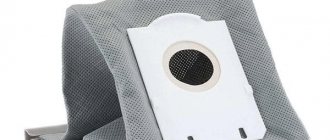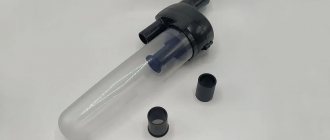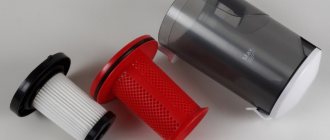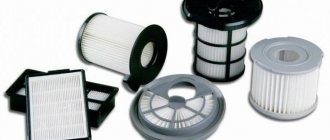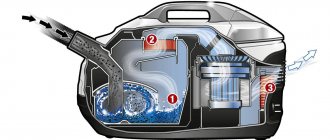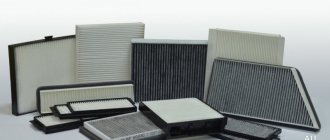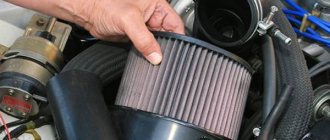Household vacuum cleaners are equipped with various filters for high-quality filtration of the air coming out after sucking up garbage; there can be from one to three of them.
Also, special garbage bags, an aquafilter and a press in a cyclone act as additional filters.
Regardless of the manufacturer of the vacuum cleaner: Samsung, Lg, Bosch, Philips, Karcher, Dyson or another brand, cleaning the same filters is carried out according to the same protocol. In this article we will tell you how to clean all vacuum cleaner filters.
Any cleaning of the vacuum cleaner is carried out only after disconnecting it from the power supply.
Types of filters
There are several types of filters:
- Bag. It can be either disposable, made of paper, or reusable, made of fabric.
- Aquafilter. The principle of operation is that dust settles at the bottom of a plastic container due to contact with water.
- Rough cleaning. There is no filtration as such, because debris and dust end up in one compartment.
- HEPA filter. Fine filter. All debris and dust microparticles envelop the system due to entanglement with its fibers. They can be either disposable or reusable.
- Cyclonic. This design provides a special flask in which centrifugal force acts. Due to this, large debris settles at the bottom of the filter.
Also, all systems are divided into primary and HEPA. Primary systems include those systems that are designed to collect large debris and dust. HEPA includes fine cleaning systems that allow you to collect the smallest microparticles of dust and allergens, including dust mites and plant pollen.
Cleaning the motor
Cleaning the motor is quite a complex matter, so it is not recommended to clean the vacuum cleaner yourself - this requires certain knowledge. In this case, it is best to entrust the vacuum cleaner to specialists. However, if urgent cleaning is necessary, or it is not possible to call a specialist, the motor is cleaned in the following way:
First of all, you need to disassemble the case; Remove the garbage bag and take out the filter; Unscrew the cover that hides the internal parts of the device; Internal parts must be blown or gently brushed with a brush.
At the same time, it is important not to compromise the integrity of all components; After all the elements are cleaned, you also need to clean the board of dirt. To do this, remove the microcircuit, clean it with a brush, after remembering how the wires are arranged; At the end of cleaning, all parts are returned to their original place.
Methods for cleaning filters
The method of cleaning the filter depends on its type and design:
- washing;
- dry cleaning;
- shaking out;
- air blowing;
- wash.
HEPA filters come in disposable and long-term use.
Disposable ones cannot be washed as they are made of paper. To clean such devices, use air blowing or cleaning with a dry cloth. However, manufacturers do not recommend constantly cleaning paper structures, but replacing them with new ones. Reusable HEPA filters can be washed under warm running water. In addition, some of them can be treated with special means to protect against the proliferation of microbes and bacteria, including mold inside the system. The bag can also be made of fabric or paper.
Paper options must be changed regularly, as they do not allow for washing or cleaning. Permanent bags are more durable. They can be shaken out, knocked out, blown with air and even washed. After washing, they must be dried thoroughly. An aquafilter, as a rule, consists of a HEPA and a flask. Such structures can be washed with water. The HEPA filter in such vacuum cleaners is often reusable, which makes it possible not only to wash it, but also to blow it with air.
The cyclone must be washed every time after each cleaning. A flask made of plastic must be washed, and HEPA, taking into account the material of manufacture, must be washed or purged.
How to wash the foam rubber pre-motor filter of a vacuum cleaner
The foam/mesh filter is used for pre-engine air purification.
The foam layer can additionally have a mesh layer of fabric; the pre-motor filter is usually paired with an additional coarse-mesh filter (also foam) - for rough air purification, it protects the motor from large debris.
How to clean the foam filter of a vacuum cleaner :
- To remove dust, remove the foam insert from the plastic case and rinse it in lukewarm water; you can pre-soak the filter for 5-10 minutes. You can use detergents, but they must be washed very well so as not to damage the vacuum cleaner.
- After cleaning the foam, leave it to dry in a ventilated place and place it back in the vacuum cleaner after 24-48 hours (after drying).
The large-mesh foam filter can also be washed well with water and inserted into the vacuum cleaner connector only after drying.
Content
Vacuum cleaners, like any other household appliances, require systematic care and timely cleaning from dirt. If you notice that the device has become worse, sucks in dust less or produces an unpleasant odor, it’s time to think about cleaning it. In this article, we will look at different cleaning methods for the main types of vacuum cleaners.
Basic rules for safe cleaning of vacuum cleaners:
- Remember to unplug the device before cleaning.
- It is better to do cleaning not in a living room, but on the street, in the garage or on an open balcony.
- Do not clean the vacuum cleaner on stairwells, under neighbors' windows, or in cramped courtyards of multi-story buildings. If your neighbors have a weakened nervous system, then such cleaning may be unsafe for your health.
Additional Tips
When cleaning a computer with an electric vacuum cleaner, it is recommended to take into account the following tips:
- Before purging, you must remove the wires from the fan.
If this is not done, then under the influence of air jets the cooler will begin to rotate, generating energy. This may lead to failure of other parts of the device. - When blowing through the system unit, it is recommended to hold the fan blades.
Due to air currents, it will begin to rotate vigorously, which can accelerate its failure. Blowing through the fan with a vacuum cleaner also negatively affects the operation of the entire computer. If it is carried out frequently, the cooler begins to cope worse with the function of cooling the computer elements, which provokes a general slowdown in its operation. - It is recommended to blow through a computer or laptop with an electric vacuum cleaner first in the air suction mode, and then in the blowing mode. This will make cleaning more effective.
It is recommended to use not an ordinary household vacuum cleaner, but a special blower to clean the computer. It is more powerful and does not generate static electricity during operation.
An air can can also be an alternative. This is a special device for removing dust from hard-to-reach places on a computer.
Thorough cleaning occurs due to the fact that the air inside the can is under pressure, and the nozzle on it is a long thin tube.
Cleaning a vacuum cleaner with a dust bag
Open the device and remove the trash bag. Disconnect the hose, remove the telescopic tube, remove the filters, and clean the working hole. Use a small brush to clean dusty grates, crevices, and other hard-to-reach areas. Wipe the cavity of the vacuum cleaner with a damp cloth and leave it open to dry.
If the vacuum cleaner is significantly dirty, then after drying, blow it with clean air. To do this, take the device to the balcony, garage or street and turn it on at full power without filters, hose and nozzles. Let it work for a few minutes. If dirt has accumulated in the engine compartment, it will fly out.
Soak the plastic hose in warm soapy water, and after a while rinse it with running water, stretching the accordion so that the water washes away the dirt that has accumulated in the folds. Also clean the telescopic tube and attachments. The carpet brush needs to be disassembled, cleaned of accumulated debris and washed.
Cleaning the brush, hose and body
The quality of operation of a vacuum cleaner largely depends on the cleanliness of any of its components. Therefore, at the final stage of cleaning, it is necessary to tidy up the surfaces of the housing and removable parts. This is done in the following sequence:
If there are no buttons, place the inner part of the hose and plastic tube under a stream of warm water. The metal part is only lightly wiped. If a large object gets inside the product, it is carefully removed using a knitting needle or stiff wire. Clean the brush attachment from debris. First, it is rubbed with your fingers, and then cleaned under water with an old toothbrush.
If animal hair or long carpet fibers are tangled in the bristles, carefully trim them with nail scissors. The cavities for placing the dust collector are wiped with a slightly damp cloth, and then with a dry soft cloth. Particular attention should be paid to the corners of the bag chamber. A layer of dust will not allow the filter to press tightly against the walls of the housing, the hose will move, and this can lead to clogging of the motor. Using a powerful air flow, the motor is cleaned. To do this, turn on the vacuum cleaner for several minutes, having previously protected the surrounding surfaces from dust with plastic film. Clean, dried parts are put into place
Finally, wipe the outer surface of the device body.
There are only two of them: dry cleaning with a compressed air stream and wet cleaning with a stream of cool water.
Manufacturers strongly discourage the use of standard detergents, solvents or household cleaning fluids for cleaning. Also, do not use any alkaline or acidic substances. Since, when air is sucked in, it passes through the entire filter system, it is possible that hazardous molecules can be absorbed and subsequently released into the environment in the form of microdispersed vapor. And this, in turn, is fraught with serious health consequences.
How to get a filter
If your device has reusable filter elements, they can be washed and washed. The plastic garbage container can be washed in running water, synthetic bags and the foam filter can be washed by hand without powder.
We suggest you read: Do I need to wash new bed linen?
What else is the equipment intended for?
Using a similar technique as washing windows, furniture is cleaned - the device is prepared for work, a brush is installed for washing flock fabric. The actions are carried out from top to bottom in dry mode, then clean liquid without cleaning agents is poured into the container. One approach is enough to refresh the upholstery. To remove dirt in hard-to-reach places, use a crevice nozzle with a narrow spout.
A washing vacuum cleaner also cleans furniture
Washing vacuum cleaner and functions:
- cleaning the floor surface;
- cleaning upholstered furniture;
- window cleaning;
- cleaning curtains;
- removing stains from tiles and linoleum.
Step-by-step instructions for removing stubborn dirt from furniture:
- prepare the composition;
- the resulting solution is poured into the tank;
- nozzles are installed;
- up and down movements under high pressure dissolve dirt;
- debris is removed from the surface using a vacuum suction;
- removal of dirty liquid;
- washing the container;
- refilling with clean water without using any products;
- additional processing.
Stages of filtration in vacuum cleaners
The vacuum cleaner sucks in air and debris due to the operation of a turbine mounted on an electric motor. To prevent all particles from passing through it, like through a pipe, and also to avoid clogging the turbine and electric motor, it implements several filtration stages:
- Rough cleaning.
- Engine filter.
- Exhaust air filter.
Rough cleaning or where garbage is stored
Typically, the function of the first filter and garbage collector is performed by either a plastic container (in more expensive models) or a garbage bag (more common in cheap models). The bag can be made either of thick fabric, in which case it is reusable, or of filter paper - it is disposable. The bag is installed between the inlet hose and the engine filter.
Paper bags are convenient because you don’t need to empty them - you clean your apartment and throw them in the trash, but you need to constantly replenish their supplies. Fabric bags are reusable, but they need to be shaken out each time and sometimes cleaned with a hard-bristled brush to remove accumulated dust deposits.
Cloth or paper bag
Models with such “filters” are especially popular because they are in the middle price segment, are easy to use and last a long time if used correctly.
Paper bags are considered disposable; they are removed and thrown away when filled without opening.
For fabric dust collectors that are reusable, the following cleaning algorithm is used:
- Remove the bag from the plastic holder inside the vacuum cleaner and carefully remove it, trying not to make sudden movements. This will prevent the spread of dust and debris.
- Transfer the bag into a large plastic bag of such a size that the dust container can be turned over and the contents can be poured out.
- After waiting for the dust to settle, carefully pull out the bag, and dispose of the plastic bag with the garbage.
- The bag is cleaned by machine or by hand, depending on the material. The dust collector should be dried naturally on a clothesline.
Most instructions on how to clean the filter of Samsung and other brands of vacuum cleaners do not recommend wet cleaning of the bags. However, it is recommended to carry out this procedure occasionally in order to achieve better cleaning of the dust collector from dirt.
Features of cleaning brushes and turbo brushes
Brushes have to be cleaned very often, as they get clogged the fastest. Not only dust, but also other debris accumulates on the fibers.
If a turbo nozzle is installed, then due to clogging of the brush it will not rotate well. Because of this, the suction power deteriorates and the engine wears out faster, as it is subject to increased load.
The turbo brush is cleaned regularly by completely disassembling it. It has a shaft mounted under the cover; it needs to be freed from debris using tweezers. Then you need to wipe off the dust from the bearings and blades. Before reassembly, the bearings are lubricated with industrial oil.
Particular attention is paid to cleaning the brush
Cleaning the coarse filter compartment
The first step is to remove the device's main dust collector, either a bag or container, depending on the model. At the same time, the algorithm for how to clean the filter of a Samsung vacuum cleaner may differ from a model of another brand, even if they have the same filtration system. It is important to carry out all actions to extract elements according to the instructions.
Modern models are equipped with three types of filters, and the cleaning algorithm for each of them is different.
Cleaning a cordless vacuum cleaner
A separate type of cyclone vacuum cleaners are cordless models. The process for cleaning them after each cleaning is as follows:
- Loosen the clamp and separate the pipe from the body and the brush from the pipe.
- Empty the container by opening the bottom lid above the trash can.
- With the container pointing downwards, turn it slightly clockwise and carefully remove it from the device body. Remove the cap from the cylindrical HEPA filter by pulling it up.
- Rotate the filter mesh clockwise (Fig. 1), remove it, and then disconnect the secondary cyclone system tube.
- Remove the cover from the filter (Fig. 2), shake off dust and rinse with cool water without any cleaning agents (Fig. 3). Also wash the plastic container.
- Reassemble the vacuum cleaner when all parts are completely dry.
Cleaning the brush, hose and body
The quality of operation of a vacuum cleaner largely depends on the cleanliness of any of its components. Therefore, at the final stage of cleaning, it is necessary to tidy up the surfaces of the housing and removable parts. This is done in the following sequence:
If there are no buttons, place the inner part of the hose and plastic tube under a stream of warm water. The metal part is only lightly wiped. If a large object gets inside the product, it is carefully removed using a knitting needle or stiff wire. Clean the brush attachment from debris. First, it is rubbed with your fingers, and then cleaned under water with an old toothbrush.
If animal hair or long carpet fibers are tangled in the bristles, carefully trim them with nail scissors. The cavities for placing the dust collector are wiped with a slightly damp cloth, and then with a dry soft cloth. Particular attention should be paid to the corners of the bag chamber. A layer of dust will not allow the filter to press tightly against the walls of the housing, the hose will move, and this can lead to clogging of the motor. Using a powerful air flow, the motor is cleaned. To do this, turn on the vacuum cleaner for several minutes, having previously protected the surrounding surfaces from dust with plastic film. Clean, dried parts are put into place
Finally, wipe the outer surface of the device body.
How to care for your turbo brush
In order for the turbo brush to serve for a long time, it needs special careful care. If there are animals in the house, then you need to clean it at least once every three or four cleanings; if not, monitor its condition and clean it as necessary.
To clean the turbo brush, arm yourself with a screwdriver and patience. Carefully unscrew all the screws and fold them separately so as not to lose them. Disconnect the cover and remove the brush shaft. Using scissors and tweezers, free it from the wound debris. Wipe dust between the blades, bearings and V-belt drive. Before installing the shaft, lubricate the bearings with liquid industrial oil. Assemble the brush, connect it to the vacuum cleaner and check the shaft rotation activity by turning on the motor at full power.
Cyclone and water filters
The algorithm for how to clean the filter of a cyclone-type vacuum cleaner differs from models with dust bags. It includes the following steps:
- Remove the container from the vacuum cleaner and shake out any accumulated debris.
- Wash the dust container under running water using plain or laundry soap and rinse thoroughly.
- Turn the container over to drain excess water and, if necessary, wipe with a clean rag.
Models with aqua filters are cleaned in the same way. Manufacturers recommend cleaning cyclone and water models after each use of the device. Otherwise, a significant reduction in suction power may occur.
How to get rid of unpleasant odor from a vacuum cleaner
An unpleasant aroma from a vacuum cleaner is usually caused by a clogged filter (main and pre-motor). Thorough cleaning of both filtration systems will often completely solve the problem.
But when the smell doesn’t go away after cleaning, it’s worth using other methods.
| Means | Description |
| Washing powder | Suitable only for vacuum cleaners with bags. Place a pinch of washing powder inside the bag (preferably with a citrus and floral scent). During operation, the vacuum cleaner will emit the aroma of the product. |
| Essential oil | Add it to the bag too - just a few drops will do the job. |
| Deodorant and air freshener | The method is suitable for any vacuum cleaner. Turn on the device, remove the brush and spray the spray directly into the suction tube. |
| Flushing the hose | When cleaning and replacing the filter does not get rid of the odor, there is a possibility that the source is located inside the hose. This element of the vacuum cleaner must be removed and thoroughly washed. |
What happens if you don't change the filter on time?
Vacuum cleaner filters play an important role in the cleaning process. They protect the device’s motor from dust contamination, overheating and operation in extreme conditions. If the filter elements are clogged, and this often happens, the suction power of the vacuum cleaner decreases. The unit begins to operate noisily. And if you don’t take action, don’t change them on time, don’t clean them, this will lead to engine failure.
Causes of clogged vacuum cleaners
The main causes of clogging are:
- high degree of contamination of premises;
- use of dust collectors made of low-quality materials;
- damage to dust collectors and cleaning devices;
- lack of elements of the cleaning system;
- loose connection of the elements of the cleaning system.
Attention! Modern vacuum cleaners are very powerful. To avoid overloading the power supply and causing damage, you should turn off all other operating household devices while cleaning.
Cleaning vacuum cleaners inside comes down to cleaning the filters and the inner surface of the housing.
